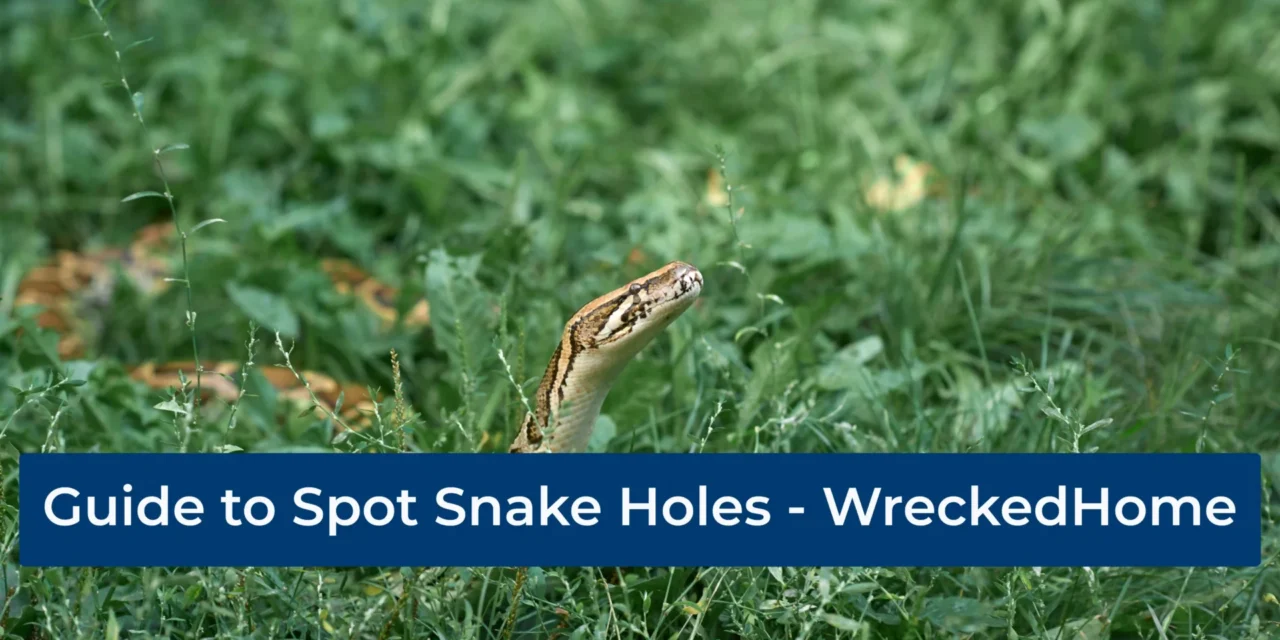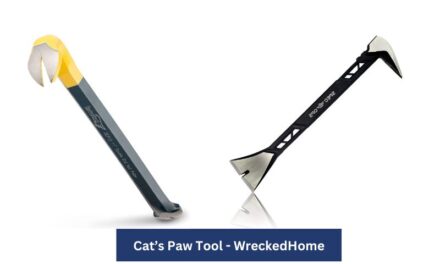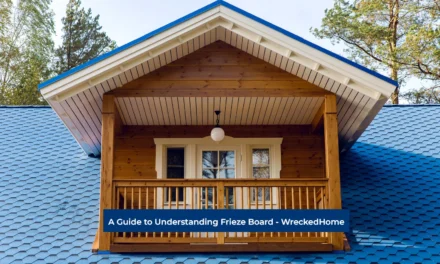If you see a burrow or hole in your yard then there is fair chance that it is a snake hole. The snakes hide in the holes for food and shelter but a surprising fact is these holes are created by other animals. Snakes just take over these holes making it hard to spot whether it is a snake hole or not. So, don’t put your (and your families’) life at risk and spot snake holes before they make it a permanent nesting area.
This guide covers everything about a snake hole. It will cover how does it look for visual identification, and the signs that snakes leave behind. In the end, you will also find the things you can do after spotting a snake hole. So, let’s explore to stay safe!
What does a Snake Hole Look Like?
Snakes cannot dig or make holes on their own so making a draft of how a snake hole looks like might not be correct. Holes are mostly created by small mammals, squirrels, rodents, bunnies, lizards or other reptiles. This is because snakes are limbless creatures with no digging capability. They can dig through the leaf debris or very loose soil but not hard surfaces.
They just come in abandoned homes or force inhabiting animals to leave it.
So, you cannot predict any size, shape or type of the holes. These are underground burrows or tunnels that provide snakes a safe shelter. You can remember that a snake hole is a dark opening that is big enough for the snake to fit through.
Some snakes like Garter snakes are 18 to 21 inches long so they find a hole that suits their size. On the other hand large snakes like Rat snakes are up to 6 feet long so living in small crevices is not possible for them and they find a long tunnel as their nesting spot. Thus, it is entirely up to the snake size and its preference to find a hole.
4 Helpful Signs to Spot Snake Holes
Now you know snakes cannot make holes and you cannot keep a record of their digging pattern, or size to exactly spot their presence. But, they leave some signs or footprints to help you trace their presence in the holes.
Here are some extremely helpful signs that will help to spot snake holes in the backyard.
Live Snake in the Hole
The first and most valid sign of a snake hole is to see the snake in it. You can observe it entering or leaving the hole.
There is no doubt that witnessing snakes activity around holes is not easy as they prefer quiet and undisturbed areas. Still you can plan it. Snakes are cold blooded and bask in the sun to stay warm and active. Snake also come out of the holes in search of food and water.
So you can record their movement without being present at the spot all the time. It will confirm that a snake is living at your place and you need to take immediate action against it.
Trace Track and Trails
If you suspect a snake is living in the hole, just trace the track around it. You can check the soft surfaces such as sandy soil, mud, or fine dust.
When a snake moves, it usually leaves a continuous, undulating imprint on the ground. This is in contrast to the distinct footprints left by mammals or birds.
The trail’s width is typically proportional to the snake’s diameter, and the patterns may vary depending on the snake’s movement style. For instance, some snakes move in a straight line, leaving a clear, straight path, while others move in an “S” pattern, creating a more wavy-trail.
Understanding these common traits can aid in recognizing snake trails and potentially leading you to the snake holes.
Visit our store for 10% off our Home Maintenance products here.
Shed Skin
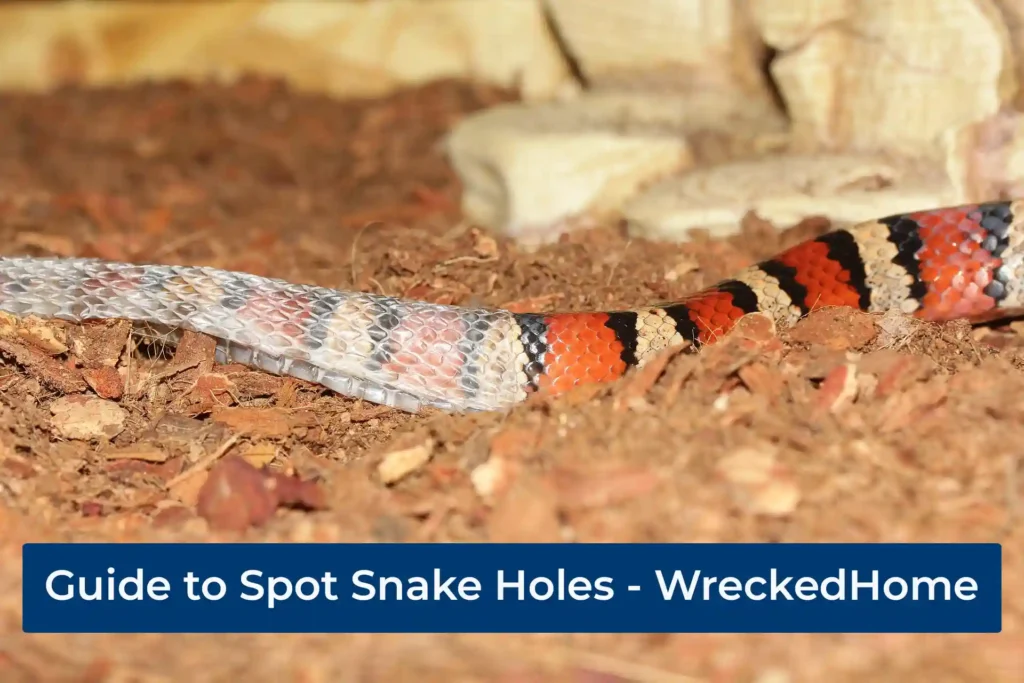
Skin shedding in the snake gives solid proof of snake’s presence at your place. This is a natural process called as “ecdysis or molting” in which snakes take off outer layer of the skin. The skin shedding is actually a part of their growth because their outer skin tightens as they grow. It becomes hard for the snakes to survive in that tight skin so they periodically shed it that is replaced by new outer skin. So, if you see the snake skin in your yard or near patio then it is a clear evidence that snakes live in the holes.
Next you can also access the condition of the skin to analyze the size of the snake living in the hole plus its activity. If the skin is of large size then you are probably facing a large snake. Similarly, what if the snake was there but is gone now? You can also carefully analyze it with the skin condition. If the skin looks fresh with no dust or debris-free then it means the snake has just shed it. On the other hand, dried skin is a sign of old shedding and there will be the chance that snake has moved on to another place.
So, it all depends on your careful inspection.
Snake Droppings
Just like any other animal, snakes expel waste as feces or droppings and you can guess snakes’ presence with these droppings. Though identifying snake droppings are hard and everybody cannot do it still careful consideration can take you to the conclusion.
So, it is important to learn how snake droppings look like for clear distinction with feces of other animals.
- First, snake droppings are usually brown to black with a white portion in it.
- The size of snake droppings varies and depends on the size of snake and its prey. Remember, snake droppings may be smaller compared to those of larger mammals.
- Similarly, you can notice a distinct smell of snake droppings.
- Unlike many mammals, snakes excrete both solid and liquid waste. You can see the slid part of the waste is the feces while chalky white part is a form of solidified urine – urate. This urate portion makes snake droppings highly recognizable.
- Lastly, you can also notice bits of bones, hair, or scales in snake’s droppings. These elements come from the prey and are only visible in snake droppings.
So, if you ever suspect a snake lives in the hole, just carefully inspect snake droppings as evidence.
What to do if you Spot a Snake Hole?
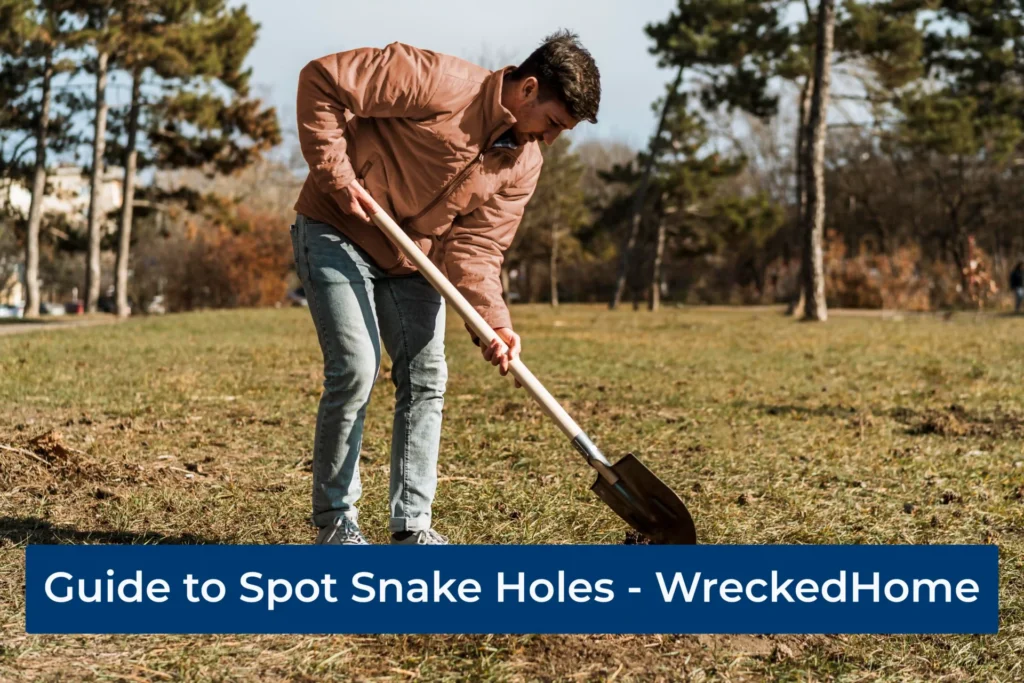
You need to be extra careful if you have successfully spotted a snake hole and follow the guidelines given below:
Keep a Distance from the Hole
Stay away from the snake hole to avoid any potential encounters with a snake. Snakes have exceptional sensing power and can attack if feel threatened.
Make sure children and pets are kept away from the hole until necessary actions are taken.
Leave the Snake Hole Alone
The next thing you can do is simply leave the hole alone if you live far away from snake hole area. Remember, not all snakes are venomous and are natural balance in the ecosystem. They eat insects, frogs, pests and other animals. In fact, most snakes quickly slither away when disturbed. But if you have spotted snake hole in your yard or house premises, the best is to move on to the next step.
Cover Snake Holes
You can cover holes in yard to block their way to the house. If the hole is in the ground, simply fill back in with dirt. On the other hand, you can use wiring, netting, or burlap to effectively block holes to prevent snakes from returning back to nests.
Use Snake Repellents
Another effective remedy to deter snakes from the holes is using snake repellents. You can find many snake repellents in the market so you can choose the best keeping in your budget. Otherwise, the best option is to use natural snake repellents in your house. Some of these repellents are sulfur, clove, cinnamon oil, vinegar, lime garlic and onion. Just spray (or pour)some of these materials inside and around the holes. The snakes have strong sense and unpleasant smell of these materials will force snakes to leave the hole at your place and find a new one.
Fumigate the Area near Snake Hole
Another thing you can do after spotting snake hole in your yard is fumigate the area. Snakes do not like any kind of smell and smoke will surely irritate them. Before fumigating, just make sure fumigation is legal in your state and you can maintain fire to your reach.
Contact a Professional
If the snake is still in the hole despite your efforts or you did not dare to deal with the danger, just call professional snake exterminators for pro services. These professionals have all necessary tools or traps to get rid of the snakes for you. Similarly, they can better assess the risk and provide the best solution to make your yard snake-free. Above all, professional exterminators educate homeowners on what types of snakes inhabit their yard and share tips on how to avoid snake entry to your place.
Conclusion – Snake Hole
Snake holes are not always easy to spot for definite size, shape or type. You need to be careful in analyzing the tracks, marks, or traces near the holes. If they coincide the snake’s presence then it shows a snake lives in that hole otherwise, it could be an old hole that the snake has left.
For any repairs, installations, builds, or questions; We recommend you to hire a professional. Find A Pro Near You Here!

